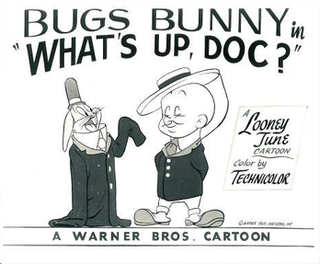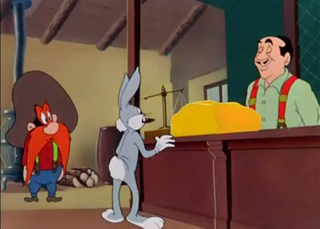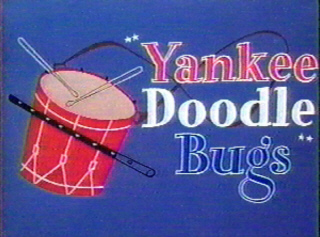Related Research Articles

Bugs Bunny is a fictional character created in the late 1930s at Warner Bros. Cartoons and voiced originally by Mel Blanc. Bugs is best known for his featured roles in the Looney Tunes and Merrie Melodies series of animated short films, produced by Warner Bros. Earlier iterations of the character first appeared in Ben Hardaway's Porky's Hare Hunt (1938) and subsequent shorts before Bugs's definitive characterization debuted in Tex Avery's A Wild Hare (1940). Bob Givens, Chuck Jones, and Robert McKimson are credited for defining Bugs's design.

Cecil Turtle is a fictional character in the Warner Bros. Looney Tunes and Merrie Melodies series of films. Though he made only three theatrical appearances, Cecil has the unusual distinction in that he is one of the very few characters who were able to outsmart Bugs Bunny, and the only one to do so three times in a row and at the rabbit's own game. Cecil often gives Bugs the taunting nickname of "Speedy" when addressing the rabbit.

Falling Hare is a 1943 Warner Bros. Merrie Melodies cartoon directed by Bob Clampett. The cartoon features Bugs Bunny.
A Wild Hare is a 1940 American animated comedy short film directed by Tex Avery, produced by Leon Schlesinger, and distributed by Warner Bros. as part of the Merrie Melodies series. The film was released on July 27, 1940, and features Elmer Fudd and Bugs Bunny, the latter making what is considered his first official appearance.

What's Up, Doc? is a Looney Tunes cartoon film directed by Robert McKimson and produced by Warner Bros. Cartoons. It was released by Warner Bros. Pictures in 1950 to celebrate Bugs Bunny's 10th birthday that year, in which he recounts his life story to a reporter from the "Disassociated Press". Bugs talks about his birth, his rise to fame, the slow years, and how famous Vaudeville performer Elmer Fudd chooses him to be part of his act. Eventually the duo comes upon their classic formula of Hunter vs. Hare. The short also was the first to use the title card music which would continue to be used in Bugs Bunny's cartoons and in most modern Looney Tunes series. Arthur Q. Bryan, Dave Barry and The Sportsmen Quartet performed voice works but were not credited.

False Hare is a 1964 Warner Bros. Looney Tunes animated short directed by Robert McKimson. The short was released on July 18, 1964, and stars Bugs Bunny.

Duck! Rabbit, Duck! is a 1953 Warner Bros. Merrie Melodies cartoon directed by Charles M. Jones. The cartoon was released on October 3, 1953 and stars Bugs Bunny, Daffy Duck and Elmer Fudd.

Hair-Raising Hare is a Warner Bros. Merrie Melodies cartoon, released on May 25, 1946. It was directed by Chuck Jones and written by Tedd Pierce. It stars Bugs Bunny and features the first appearance of Chuck Jones' orange monster character "Gossamer".

The Looney Looney Looney Bugs Bunny Movie is a 1981 American animated comedy package film with a compilation of classic Looney Tunes/Merrie Melodies Warner Bros. cartoon shorts and animated bridging sequences produced and directed by Friz Freleng, hosted by Bugs Bunny. The new footage was produced by Warner Bros. Animation and the first Looney Tunes/Merrie Melodies film with a compilation of classic cartoon comedy shorts produced by Warner Bros. Animation.

Haredevil Hare is a 1948 Looney Tunes cartoon directed by Chuck Jones. It stars Bugs Bunny and it is the debut for Marvin the Martian — although he is unnamed in this film—along with his Martian dog, K-9. Marvin's nasal voice for this first film is different from the later one he is most known for. This is also the last pre-August 1948 Looney Tunes and Merrie Melodies cartoon whose copyright was sold to Associated Artists Productions.
Hare We Go is a 1951 Warner Bros. Merrie Melodies cartoon directed by Robert McKimson. The short was released on January 6, 1951, and features Bugs Bunny.

14 Carrot Rabbit is a 1952 Warner Bros. Looney Tunes animated cartoon short directed by Friz Freleng. The short was released on March 15, 1952, and features Bugs Bunny and Yosemite Sam. The title is a play on "14 karat", as in a purity level for gold.
Clyde Bunny is a cartoon character who appears in three Looney Tunes shorts. He is the nephew of Bugs Bunny.

Rabbit Every Monday is a 1951 Warner Bros. Looney Tunes cartoon directed by Friz Freleng. The short was released on February 10, 1951, and stars Bugs Bunny and Yosemite Sam. The title is a play on Chicken Every Sunday.
Bugs Bunny's Howl-oween Special is a Looney Tunes animated Halloween television special directed by David Detiege, which first aired on CBS on October 26, 1977.

Forward March Hare is a 1952 Warner Bros. Looney Tunes cartoon directed by Chuck Jones. The short was released on February 14, 1953, and stars Bugs Bunny.

Yankee Doodle Bugs is a 1954 Warner Bros. Looney Tunes cartoon short, written by Warren Foster and directed by Friz Freleng. The short was released on August 28, 1954, and stars Bugs Bunny.

Now Hare This is a 1958 Warner Bros. Looney Tunes cartoon directed by Robert McKimson and written by Tedd Pierce. The short was released on May 31, 1958, and stars Bugs Bunny.
Bugs Bunny in Space is a Looney Tunes television special that originally aired on CBS September 6, 1977. Assembled to capitalize on the enormous success of the original Star Wars film in summer 1977, the special is a compilation of clips from science fiction themed Warner Bros. Cartoons, including Duck Dodgers in the 24½th Century.
References
- ↑ Beck, Jerry; Friedwald, Will (1989). Looney Tunes and Merrie Melodies: A Complete Illustrated Guide to the Warner Bros. Cartoons. Henry Holt and Co. p. 226. ISBN 0-8050-0894-2.
- ↑ Lenburg, Jeff (1999). The Encyclopedia of Animated Cartoons. Checkmark Books. pp. 58–62. ISBN 0-8160-3831-7 . Retrieved 6 June 2020.